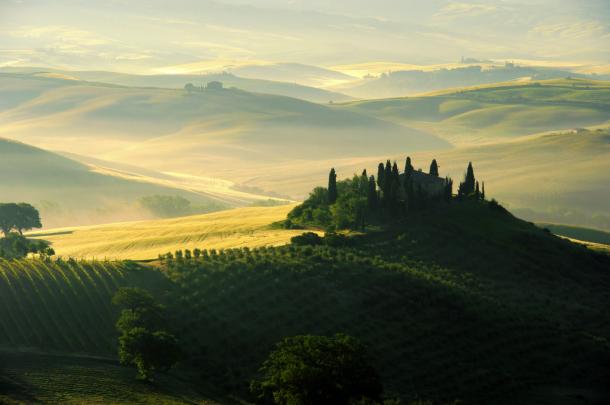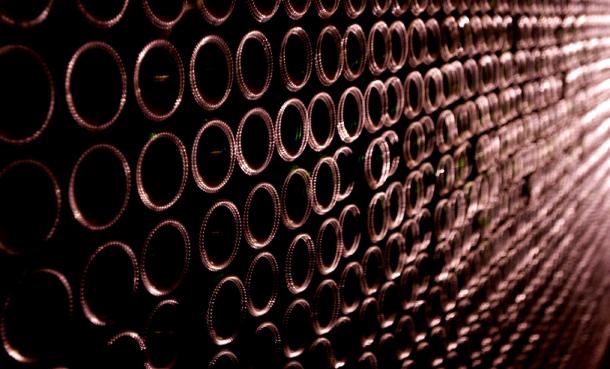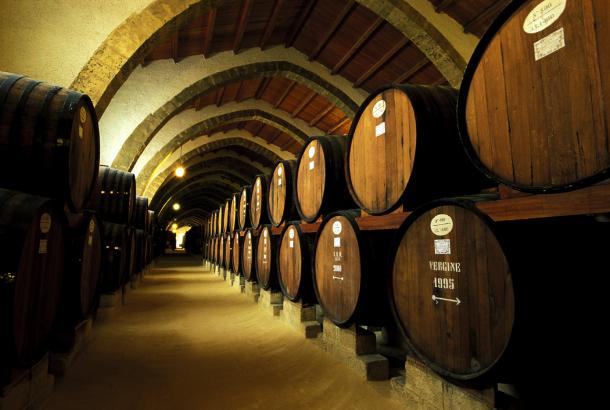An Introduction to Italian Wines by Victor Hazan
Unlike food, wine in Italy has changed dramatically, in the last 25 years. For one thing, I think the biggest change to have taken place is that Italians realized that they could make very great wines only if they paid extraordinary attention to their vineyards. They stopped using so many fertilizers and chemicals. When they decided to give up hopes of growing huge quantities of grapes per acre, they discovered that even ordinary grapes like Trebbiano could produce tremendous results. So this has really sparked the revolution in Italian wine quality.

Certainly, as far as red wine is concerned, Italy can make the world’s greatest red wine both for everyday use and for very special occasions. People like Angelo Gaia set the example by no longer fertilizing, no longer using chemicals, but producing very small quantities of grape bunches per vine, and that is really the secret.
Of course other changes in red wine have taken place. Once upon a time, not too long ago, actually a quarter of a century, there were so many old musty stinking barrels in Italian cellars. Today most of those have been replaced by clean new barrels or stainless steel, and the very important trend in some wineries of using small French oak barrels, called “barrique”, they way they do in California, Australia, South Africa, wherever international style red wines are being made.
The leading region in innovation was Tuscany. It found itself at the end of 1960s with an almost-catastrophe on its hands, nobody was buying Chianti wine, it was an awful wine, harsh, short-lived, too light-colored. They completely revamped their approach to winemaking and wine cultivation. The producer that got the most credit for the revolution in Tuscany was Antinori, but with historical movements somebody may get the credit for leading them but a lot of influences contribute to the overall results. There were other producers doing the same thing.
Piero Antinori is an extremely far-sighted, intelligent, hard-working and perceptive wine-maker. He’s really a hands-on owner. That’s unusual in Tuscany where the owners are signori (gentlemen). Piero Antinori is a signore but he works hard. He had a very gifted enologist, Giacono Tachis, and together they dedicated themselves to improving the wines. There were others, some smaller, like San Felice, that also did some very innovative things.
Italian producers were not selling as well as they should have, they were in deep economic trouble, but they were smart enough to realize tht the only way they could compete in the market was to improve the quality. We still have great big wine producers, the big industry, who were princpipally responsible in those early years for the kind of Italian wine that people bought abroad. The jug wine, the Soave for $3.49 a bottle. We still have some of those, but what has happened now, at least in the American market, is that people are buying the quality wine. Quality producers do not have a lot of trouble selling their wine. When Italian wine is produced to a certain standard of quality it stands out.
It stands out because Italian wine is idiosyncratic, it has a flavour you can only get from an Italian wine. You cannot get the flavour of a real Chianti in any other place in the world. Or the flavour of a Barolo, or a Barbaresco, or a Dolcetto, or a Rifosco. Italian wines have an individual character, and you can scour the world and you come up with Carbenet Sauvignon, Pinot Noir and such, but you cannot come up with these standbys that are so Italian. Italian wine like Italian food has a very distinct, satisfying character.

The region that had the greatest natural potential was Piedmont, because it had the greatest number of varieties of great grapes. They also had the greatest tradition in Italy for making prime wine, but they had also gotten stuck in a rut. They had stopped really tasting their own wine. Since they were Piemontese, and had this great old reputation, they felt they were good enough. But it was time to change, and the one man who helped turn them around was Renato Ratti. Unfortunately he died tragically of lukemia just at the very height of his powers. He was the first to go around and tell people – look, you are making bad wine. This is what you need to do to make good wine. Then Angelo Gaia, from Piemonte, came along, and he’s been an enormous force. He was able to establish a price structure for Italian wines that even some first-rate Bordeauxs can’t equal. He can sell a Barbareschi for $125 a bottle.
In the end wine is a business, you don’t do it for idealism or because it’s a religion. When you, the Italian winemaker, see that some wines are getting these prices, and they are aquiring renown all over the world, you look at what you are doing and see if you can’t make it better yourself. A legion of young wine makers have followed Angelo Gaia’s example, cutting down yields, making fresher wine, not keeping it in stinking old barrels for such a long time. The whole secret of a good wine is that, since wine is made from a fruit, the wine should always taste of a fresh fruit. A wine that tastes old is never a great wine. And a wine, even if it is a great wine for long developing, if it is not appealing as a young wine it is never going to be good. It develops its character but it never changes its intrinsic fruit quality.
There have been enormous changes from the beginning of the seventies to this last decade. The two regions that are the locomotives of Italian wine making are Tuscany and Piedmont. If you want to include white wines there is Friuli. There is some good wine made in the Veneto, not as much as there could be because they produce a lot. Allegrini, for example, makes a wonderful Valpolicella, and then there’s a wonderful man named Pieropano who makes a great Soave.

I’d like to mention that Italy has extraordinary dessert wines. Dessert wines are perhaps the finest manifestation of the winemakers art. To make a really well-balanced cool clean-tasting sweet wine is a very great achievement. Vin Santo is a peculiar wine, because it can be sweet, or not sweet. There’s no control over what is going to happen, it may turn to vinegar, it may turn into a sweet wine, it may turn into a sherry-like wine. It is cemented into a barrel for four or five years. It’s a less constant wine, it varies from producer to producer and from year to year.
Each part of Italy makes a great dessert wine, from the very far north all the way to Pantelleria which is in the latitude of the north coast of Africa. Ideally a dessert wine should be drunk before coffee and before dessert, then enjoy the dessert, or skip it altogether. You can’t really appreciate it completely when your palate is covered with the sweet of the dessert. The sweet wines are also delicious with ripe cheeses, like a very ripe gorgonzola or a very ripe brie, or some of those very ripe goat cheeses from Piedmont.
To conclude, if you have an unbiased palate and you are looking for flavour, for freshness, for fruit, you will probably find it more easily in an Italian red wine than in any other red wine. White wine is a subject apart. If you are looking for a white wine something like a California Chardonnay, or some of the white Burgundies, Italy doesn’t do that particular kind of white wine well. But it does beautiful clean, fragrant, aromatic white wines like Pinot Bianco, Pinot Grigios, Soaves, Italy does those very well. They are fresh and light.
Text Copyright © Victor Hazan, all rights reserved
